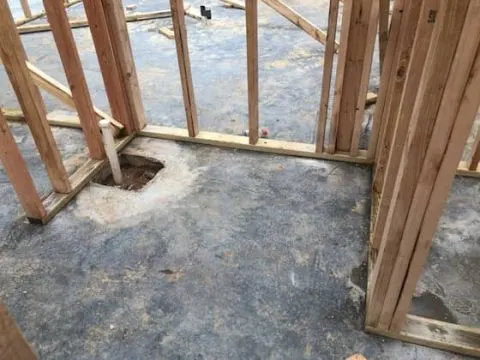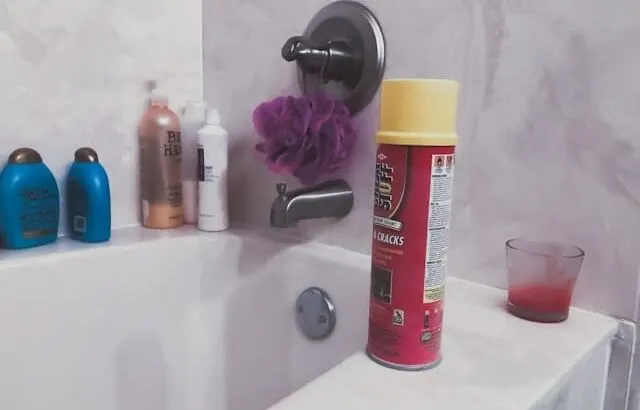When a bathtub flexes under weight or is noticeably cold, spraying expanding foam underneath is a commonly recommended solution in the DIY community. Let’s see if this approach is viable.
Can expanding foam be used under a bathtub? Yes, expanding spray foam can be used under a bathtub. It can reduce coldness and flex in an existing install, but an improper application can result in additional problems.
It’s important to understand that the tried-and-true best practice for preventing flex in a newly installed bathtub is with a mortar slab. But if you are dealing with an existing install and removing the tub isn’t practical, spray foam actually offers appealing benefits.
Why Does A Bathtub Need Support Under It?
Many people don’t realize this but a bathtub bottom does not usually rest squarely on the floor. In fact, many tub bottoms actually do not touch the floor at all without bracing or support of some kind being installed underneath them.
The reason for this is that the bottom of bathtubs is not flat and level. They are designed with a slight incline to facilitate the movement of water toward the drain.
But this design feature is also a bit of a design flaw. Because, without proper bracing or support, the bottom of the tub is essentially suspended above the floor.
And so, you end up with this void under the bathtub. This is the reason people often have issues with flexing of the bathtub bottom.
How Does Spray Foam Compare to Other Stabilizing Products?
To fill the gap under a tub, there are several potential approaches. However, they do not offer the same benefits. Some, quite frankly, are promoted as solutions without any sufficient evidence.
These are the common products used for filling a void under a bathtub:
| Stabilization Product | Pros | Cons |
| Joint Compound | None | Won’t hold up to pressure under tub |
| Sand | None | Does not rebound, deflects |
| Thin Set Mortar Mix | Readily available Inexpensive | Hard to break if you need to move or reset it |
| Plaster of Paris | Readily available Inexpensive | Easy to manipulate |
| Mixed Grout | Expensive | Little to no shrink |
| Spray Foam | Readily AvailableInexpensive | Easy to manipulate |
As you can see, Plaster of Paris is a good alternative to spray foam for stabilizing and firming the bathtub upon installation. However, it may not be the easiest product to use when working with an existing tub. Accessing the space would prove messy and confining compared to spraying expanding foam into the gaps.

How Does Spray Foam Compare to Other Insulation Techniques?
Besides providing stabilization, you may be looking for ways to insulate your existing bathtub to reduce heat loss. Often, the tub was not properly insulated upon installation, especially on the exterior wall, allowing the cold air outside the home to decrease the temperature of the tub (source).
Spray foam is one alternative to mitigate this problem. Let’s look at some other options before discussing spray foam in more detail.
- Fiberglass batting insulation
- Rigid foam board sheet insulation
- Blown-in loose fill
All of these options can provide insulation under and around a bathtub. Here are some considerations:
- Fiberglass batting would be the easiest to install yourself, but it does potentially create moisture and mold issues.
- Rigid foam board provides great moisture resistance, but it does not form into the awkward shapes under and around a bathtub.
- Blown-in loose fill is effective for shaping into the gaps, but it is usually only installed by professionals.
As you can see, the alternatives to spray foam for insulating your bathtub have challenges that may not make them the best solutions.
So spray foam does provide an easy do-it-yourself solution for both the insulation and support issues. It’s not going to provide the level of support that a mortar slab will give and it’s no replacement for proper insulation practices.
That being said, if you are trying to improve the stability and insulation of an existing install, it is an option.
Related Reading: Using Spray Foam Under A Shower Pan: Pros, Cons, & Cautions
How Does Spray Foam Work and What Are Its Benefits?
Spray foam is a polyurethane foam that comes in either a closed-cell or open-cell foam, which determines its density. They set differently.
- Closed-cell foam forms bubbles with solid walls that trap gases inside them.
- Open-cell foam forms bubbles with broken walls that allow air to fill them.
This also affects its moisture resistance and air flow capabilities. Let’s compare:
| Closed-Cell Spray Foam | Open-Cell Spray Foam |
| Higher R-value/Insulation effectiveness | Lower R-value/Insulation effectiveness |
| Lower moisture permeability | Higher moisture permeability |
| Good air barrier | Lower air barrier unless thick |
| Higher strength and rigidity | Lower strength and rigidity |
| Resists water | Not suitable for direct contact with water |
As you can see, closed cell spray foam is better for a bathroom application, as it provides better moisture protection, insulation, and strength.
Polyurethane foam is created by a chemical reaction between 2 liquids. However, most common aerosol spray can forms, like Great Stuff, have already been partially reacted and complete the process upon spraying (source).
Great Stuff has several closed-cell products available for different applications. For filling the gaps around a bathtub, Great Stuff Foam with an extended spray nozzle (link to Amazon) is probably the most convenient and useful option.
This will allow you to get further underneath the tub. I would not recommend a highly expanding foam for this but rather a low expanding option. This will help to prevent damage to the tub.
Concerns for Expanding Foam Under-Bathtub Installation
When applying polyurethane spray foam under a bathtub, there are a couple of potential issues to keep in mind.
First is maintaining access to plumbing and controls, should you need to make repairs to them in the future. Spray foam can be removed, but it is easier to leave space to work around these items. I would, however, make sure that any piping leading into the wall or floor is foamed to prevent air leaks. The connections and joints are the areas you want to make sure you have access.
The other concern is providing room for the expansion of the product. You could potentially lift the tub off its base or off the ground by over-spraying, and end up with a problem as this guy did.
This would of course create extra work removing the foam, realigning the tub, and starting over.
You can mitigate this problem by filling the tub with water before spraying the polyurethane foam. The weight of the water would help to keep the tub in place while the foam reacts and fills the spaces around it.
It’s important to understand that the foam is going to push somewhere when it expands. There would need to be plenty of open space around the sides of the tub where the foam can expand to.
Expanding foam can exert tremendous force when swelling in tight spaces. I’ve seen large gap foam warp window and door frames when used inappropriately. It’s even used to raise concrete sidewalks and foundations (source).
The last thing you want is to make a bad situation worse.
Conclusion
Expanding foam can be used in under-bathtub applications. It is not a replacement for a mortar slab in new installs but is a practical solution for improving stability and insulation of an existing tub.
In fact, when working with an existing tub, spray foam may provide the only option for preventing the fiberglass from flexing under weight by filling the spaces underneath.
Likewise, spray foam is a viable and easy option for increasing the warmth in and around an uninsulated bathtub.
Just be sure to fill the tub before applying the product if you don’t want to create more work redoing an over-insulated, floating tub. And as always, if you are not comfortable and familiar with what you doing, seek the advice of a pro.
Recommended Reading:
- Using Spray Foam Under A Shower Pan: Pros, Cons, & Cautions
- Can I Install a Bathtub Myself? Considerations And Steps
- Does a Bathtub Need a P-Trap?
- Can You Install a Bathtub Over Tile? Read This Before You Do
As a homeowner, I am constantly experimenting with making the structure of my house more energy-efficient, eliminating pests, and taking on DIY home improvement projects. Over the past two decades, my family has rehabbed houses and contracted new home builds and I’ve learned a lot along the way. I share my hard-learned lessons so that you can save time and money by not repeating my mistakes.


Leave a comment
You must be logged in to post a comment.